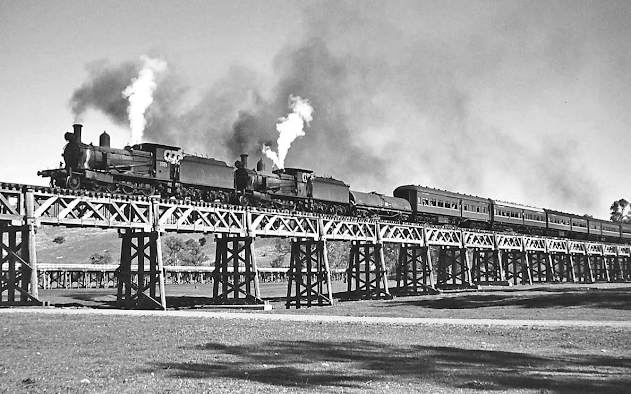20121203 NSW Wagga Wagga
20121203 It’s sad to
leave such a great camp location especially since I was beginning to get use to the
very cold water only, we are running out of supplies. We head back to Wagga Wagga to restock our supplies and
check out some sites. There's the bridge I read about, pull over Des, and surprise, surprise he did so I took my photos and headed to town. After shopping we went in search of the Quinty Cake and Bake House built in the early 1900 but couldn't find it, not even the information center could help so we left for Gundagai stopping on the way to check out the RAAF Heritage Centre.
 The
railway houses over 500 historic railway items from catering to stationary
equipment through to communication devices and mechanical
The
railway houses over 500 historic railway items from catering to stationary
equipment through to communication devices and mechanical
 RAAF Wagga Heritage Centre Showcases Air Forces history, along with
representing the significant involvement of the RAAF in the Riverina Region of
New South Wales. The static aircraft
display next to the Heritage Centre, represents over 50 years of RAAF flying
history.
RAAF Wagga Heritage Centre Showcases Air Forces history, along with
representing the significant involvement of the RAAF in the Riverina Region of
New South Wales. The static aircraft
display next to the Heritage Centre, represents over 50 years of RAAF flying
history.
Wagga Wagga is
the state’s largest inland city nestled on the banks of the Murrumbidgee
River. The Wiradjuri were the largest
Aboriginal tribe in New South Wales and it is from their language the city is
named. The word “Wagga”, means crow and
repeating it means the plural, hence “the place of many crows”. In 1829 Charles Sturt was the first explorer
to visit the site and squatters followed not long after and in 1849 became a
village which grew quickly and by 1870 the town was gazetted as a township. During WW1 the town was the starting point
for the Kangaroo recruitment march, one of a series of snowball marches
conducted in NSW during the war where groups of recruits would march towards
Sydney and appeal to men in the towns along the route to join them and enlist
in the Australia Imperial Force.
Constructed in
1894, it was the first of engineer Percy Allen’s 33.5 span timber truss bridge,
he designed the third of the five standard timber truss bridge designs
developed in NSW. He based his design on
the American Howe bridge but exploited the superior strength and performance of
Australian ironbark to reduce it to the barest essentials, in doing so he
devised an efficient and graceful truss bridge design.
Built in the
Victorian style, Wagga Wagga Railway Station was opened in 1879 and was
designed by John Whitton, who is affectionately known as the ‘Father of the
N.S.W Railway’.
 The
railway houses over 500 historic railway items from catering to stationary
equipment through to communication devices and mechanical
The
railway houses over 500 historic railway items from catering to stationary
equipment through to communication devices and mechanical
Built in 1881
this majestic
building is the heart of the city’s precinct, originally the City’s town Hall
and Municipal Office as well as the seat of Local Government until 1999 when it
was converted into the Museum of Riverina.
Originally presented to the Wagga Wagga hospital by Frederick Chisholm in 1885, which soon after he was elected president of the hospital committee,Gee I wonder way. Later moved to the Victoria gardens in 1929 after the hospital was moved, then after months of restoration it was mover to the Victoria Memorial Gardens in 1977.
I hate the bloody tree in front of old buildings. The first church
on this site was begun in 1850 and was declared a parish in 1855 and the first service
was held in 1860. Being too close to
flood waters the old building was demolished and a new one was designed and built
and finished in 1876.
The original
presbytery was built around 1871 and was a one storey brick building that was incorporated into the
centre of the present building completed in 1902.
 RAAF Wagga Heritage Centre Showcases Air Forces history, along with
representing the significant involvement of the RAAF in the Riverina Region of
New South Wales. The static aircraft
display next to the Heritage Centre, represents over 50 years of RAAF flying
history.
RAAF Wagga Heritage Centre Showcases Air Forces history, along with
representing the significant involvement of the RAAF in the Riverina Region of
New South Wales. The static aircraft
display next to the Heritage Centre, represents over 50 years of RAAF flying
history.
Designed in U.K & named Camberra in a ceremony on 19-01-1953 by Sir Robert Menzies. 48 Camberra were constructed in Australia replacing the Avro Lincolns which were heavily involved in bombing operations against the communist forces in Malaya. Then leaving for Phan Nang in 1967, during it's stay the squadrons Camberra's flew 11,696 operational missions dropping 76,389 bombs, she retired in 1982.
One of the most successful
and widely used French built aircraft; the single seat/engine fighter was
developed for high altitude, all weather combat, but has been employed in
ground attack, nuclear strike, and exploration and training roles. Its first flight was in 1956, a great year.












Comments
Post a Comment